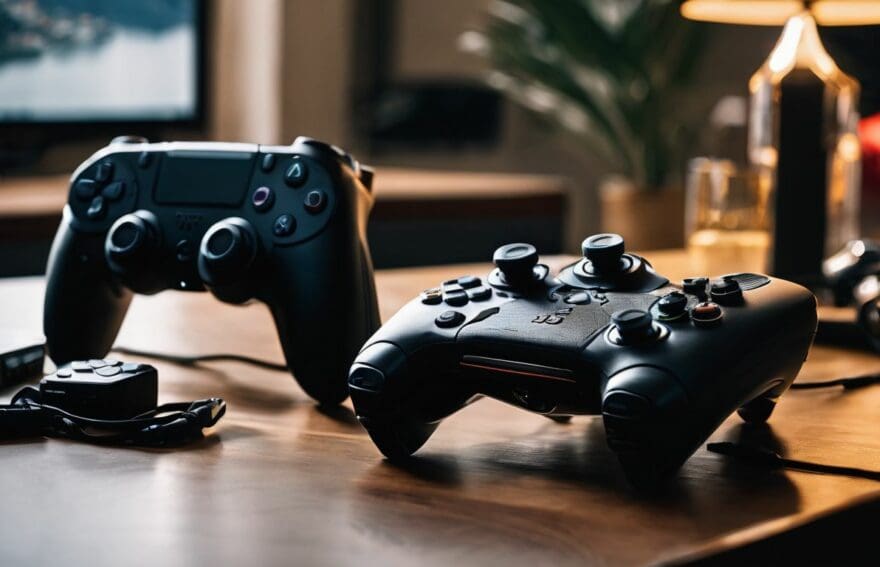FGC Storylines: The Rivalries and Friendships That Define the Scene

Updated On: November 29, 2025 by Aaron Connolly
Venturing into the adrenaline-fuelled realm of fighting games encompasses far more than mere hand-eye coordination; it’s a narrative-rich experience steeped in personal rivalries. The gentle quiver of my own joystick has borne witness to clashes that stretch beyond the screen – they’re moments where bonds are forged or frayed, etching themselves into the very fabric of gaming kinship.
As you delve deeper with me in this blog post, we’ll explore how these spirited duels shape the essence of the Fighting Game Community (FGC) scene and bring to light legendary face-offs such as GO1 versus SonicFox.
Stay tuned for engaging anecdotes bespeaking unity and rivalry alike – rest assured, these sagas transcend mere pixels and button mashes.
The Power of Friendly Rivalries in the FGC
Friendly rivalries have the power to drive growth and competition within the FGC, pushing players to improve their skills and elevate their gameplay. Examples from popular fighting games demonstrate how these rivalries can ignite passion and dedication within the community.
How rivalries can drive growth and competition
In the FGC, rivalries push us to sharpen our skills and innovate new strategies. Take the intense competition between Goichi “GO1” Kishida and Dominique “SonicFox” McLean in Dragon Ball FighterZ; it’s more than just two players clashing—it’s a spectacle that captivates and pulls in crowds.
These showdowns excite spectators, inspire up-and-coming players, and often lead to unforgettable moments that define the game’s history. As we train harder to best our rivals, everyone raises their level of play, driving growth within the community.
Seeing competitors go head-to-head fosters a fierce but amicable rivalry that benefits us all. It’s this formula that keeps tournaments electrifying and encourages newcomers to become part of our dynamic scene.
With every match-up comes a chance for someone new to leave a mark on the competitive landscape or even flip an adversarial relationship into one of mutual respect – similar to those iconic anime friendships born from enmity.
Next up, let’s delve into how these rivalries evolve over time as former adversaries grow closer both in and out of the arena.
Examples from popular fighting games
- Street Fighter series:
- Tekken series:
- Mortal Kombat series:
- Super Smash Bros. series:
The Evolution from Rivals to Friends
Through the thrill of competition, rivalries can lead to unexpected friendships within the FGC. The bond formed through competing against each other can often evolve into a shared passion for the game and a sense of camaraderie among players.
https://www.youtube.com/watch?v=5eA1FE417PQ
The bond formed through competing against each other
Competing against each other in the FGC forms a unique bond that goes beyond just a simple rivalry. It’s about mutual respect, understanding, and an appreciation for each other’s skills and dedication to the game.
This competitive camaraderie is what often leads to lasting friendships within the community, as players share their passion for gaming while pushing each other to new heights in their gameplay.
The bond formed through competing against each other creates a sense of companionship that enriches the overall experience within the FGC.
Building a community through shared passion for the game
The bond formed through competing against each other paves the way for building a community through shared passion for the game. Passionate gamers and novices alike are drawn together, forming a vibrant and supportive atmosphere based on their mutual love for gaming.
This shared enthusiasm creates an inclusive space where members encourage one another to grow, learn, and succeed in the world of competitive gaming. The FGC serves as a prime example of how fostering connections through a common interest can create a thriving and dynamic community where competitive relationships evolve into deep-rooted friendships, ultimately defining the scene with camaraderie and sportsmanship.
The Top FGC Friendships Turned Rivalries
Explore some of the most iconic friendships turned rivalries in popular anime and gaming culture, from the intense bond between Goku and Vegeta to the complex dynamic between Naruto and Sasuke.
These adversarial friendships have captivated audiences with their fierce competition and evolving relationships.
Peter Prickly and T.J. from “Recess”
Peter Prickly and T.J. Detweiler’s relationship in “Recess” exemplifies the blend of friendly rivalry and genuine friendship within the FGC storyline. As school principal versus student, their interactions on the playground mirror the competitive spirit seen in fighting games.
Despite their opposing roles, they share moments of camaraderie that transcend their positions, highlighting how rivalries can foster unexpected bonds.
While Peter and T.J.’s dynamic is not from a video game or anime series, it showcases how diverse narratives — including those from children’s television shows — can inspire engaging storylines within the FGC community.
Goku and Vegeta from “Dragon Ball Z”
Goku and Vegeta from “Dragon Ball Z” exemplify an enduring rivalry that evolves into a deep friendship. From their first encounter as fierce adversaries, the two warriors push each other to greater heights, driving the evolution of their abilities and character development while developing a mutual respect and understanding.
Their dynamic illustrates how rivalries can shape not only individual growth but also foster lasting friendships within the FGC community.
The iconic friendship between Goku and Vegeta portrays the transformative power of competition, showcasing that even in intense rivalries, there is potential for camaraderie to flourish.
Naruto and Sasuke from “Naruto”
In “Naruto”, the relationship between Naruto and Sasuke evolves from bitter enmity to a deep friendship. Despite their intense rivalry, they develop a strong bond through shared experiences and facing formidable opponents together.
Their competitive spirit drives them to push each other’s limits, ultimately leading to mutual respect and understanding. The evolution of their relationship showcases the potential for lasting friendships to emerge even in the midst of fierce rivalries.
The storyline of Naruto and Sasuke embodies the transformative power of friendly competition, demonstrating how rivalries can fuel personal growth and foster enduring friendships within gaming communities.
Natsu and Gajeel from “Fairy Tail”
Natsu and Gajeel from “Fairy Tail” exemplify a compelling friendship that emerged from a fierce rivalry. Their intense competition fueled their growth as individuals and teammates, demonstrating the impactful bond formed through adversarial encounters in the anime world.
Despite their initial bitter enmity, Natsu and Gajeel’s evolving relationship showcases the potential for camaraderie amidst animosity, adding depth to their characters’ development within the narrative of “Fairy Tail.” The dynamic between these characters highlights the human elements of competition, mirroring real-life instances where lasting friendships are forged despite fierce rivalries.
Moving on to [Next Heading]..
Yusuke and Hiei from “Yu Yu Hakusho”
Transitioning from the fierce rivalry between Natsu and Gajeel from “Fairy Tail,” we delve into the complex dynamic between Yusuke and Hiei from “Yu Yu Hakusho.” Their relationship exemplifies how rivalries can evolve into deep friendships, transcending initial animosity.
From their early clashes to uniting against common foes, Yusuke and Hiei’s journey showcases the transformative power of competition in forging unbreakable bonds within the FGC community.
The storyline of Yusuke and Hiei highlights an enduring theme in the FGC: bitter enmity turning into mutual respect and camaraderie. As passionate gamers, this narrative resonates with us as it mirrors our experiences in building relationships through competitive gaming.
Jack Atlas and Yusei from “Yu-Gi-Oh! 5D’s”
The fierce rivalry between Jack Atlas and Yusei from “Yu-Gi-Oh! 5D’s” showcases the classic dynamic of an intense competition that transforms into a deep, lasting friendship. Their journey is marked by bitter enmity turned into mutual respect through their shared passion for the game.
The storyline of their evolving relationship reflects the human elements of competition, highlighting the ability to forge profound friendships despite fierce rivalries. The dynamics between Jack and Yusei resonate with both passionate gamers and novices alike, serving as a compelling example of how gaming friendships can arise amidst intense competitive gameplay within the FGC community.
The Impact of FGC Storylines on Sports Films
The impact of FGC storylines on sports films is profound, as they often share similar themes of overcoming obstacles and defying expectations. These narratives translate the drama of rivalries into compelling underdog stories that resonate with a wide audience.
Overcoming obstacles and defying expectations
Overcoming obstacles and defying expectations is a central theme in FGC storylines, mirroring the real-life challenges of competitive gaming. It often involves underdog characters who rise above adversity to achieve success, captivating audiences with their determination and resilience.
These narratives resonate strongly with gamers, inspiring them to push beyond their limits and pursue their goals relentlessly. Whether it’s in video games or sports movies, the theme of overcoming obstacles and defying expectations captures the essence of the human spirit striving for greatness.
In addition to portraying personal triumphs, this theme also highlights unexpected turnarounds in relationships, particularly rivalries evolving into enduring friendships. This storyline adds depth and complexity to character dynamics within the FGC community, presenting an authentic portrayal of human connections forged through shared passions and mutual respect.
Creating compelling underdog stories
Transitioning from the theme of overcoming obstacles and defying expectations, we delve into the captivating world of creating compelling underdog stories within the FGC. These narratives showcase individuals or teams who rise above their limitations to achieve greatness, often against all odds.
One such example is seen in Cero Miedo’s journey in Lucha Underground, where his underdog spirit captivated audiences as he battled formidable opponents. Additionally, these stories resonate with fans due to their relatable themes of perseverance, determination, and resilience – qualities that are universal and timeless.
In these gripping storylines, viewers witness characters who may initially be underestimated by others but ultimately prove themselves through sheer dedication and unwavering resolve.
Translating the drama of rivalries into film
The FGC storylines and the intense rivalries within the community provide compelling narratives that can be translated into captivating sports films. These stories often revolve around underdogs defying expectations, creating engaging plotlines for movies.
The dynamics of friendships evolving from bitter enmity in video game rivalries also offer rich material for filmmakers to explore complex character relationships, adding depth to their storytelling.
Additionally, the potential for unlikely friendships amidst fierce competition serves as a promising storyline that resonates with audiences and creates an emotional connection between characters.
Conclusion: The Importance of Building and Supporting Local FGC Communities
Friendships and rivalries within the FGC are essential for its growth. They create a sense of community, drive competition, and form compelling storylines. The bond formed through fierce competition can evolve into enduring friendships.
It is crucial to nurture and bolster local FGC communities to sustain these vibrant dynamics.
FAQs
1. What are FGC storylines all about?
FGC storylines often feature player rivalries and close friendships, mimicking the tropes of anime rivalries and bromance, which add drama to the esports tournament scene.
2. How do rivalry and friendship impact players in the FGC?
In the FGC, both rivalry and friendship can fuel competition; bitter enmity may turn into deep comradeship as players repeatedly face off in tournaments.
3. Are there any famous rivalries or friendships within the FGC community?
Yes, within the esports community of the Fighting Game Community (FGC), there are many well-known instances of hostility that evolve into hostile friendships or enduring bonds among competitors.
4. Why are these dynamics important for understanding FGC tournaments?
The dynamics between players—whether it’s betrayal or loyalty—as seen through their rivalries and friendships shape community engagement and bring exciting narratives to each match in a tournament.
5. Can real-life relationships between players affect outcomes in competitive play?
Real-life relationships can significantly influence how matches unfold during competition, with some pairs showing great sportsmanship as they shift from combatants to comrades in competition.


